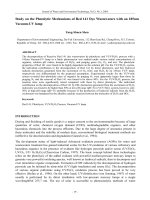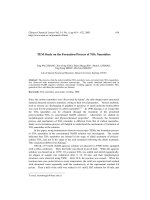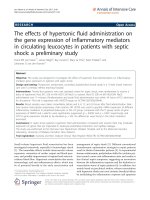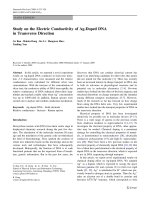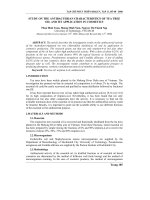Study on the downstream targets of DELLA proteins in arabidopsis thaliana
Bạn đang xem bản rút gọn của tài liệu. Xem và tải ngay bản đầy đủ của tài liệu tại đây (5.05 MB, 179 trang )
I
STUDY ON THE DOWNSTREAM TARGETS OF
DELLA PROTEINS IN ARABIDOPSIS THALIANA
FANG LEI
NATIONAL UNIVERSITY OF SINGAPORE
2010
II
STUDY ON THE DOWNSTREAM TARGETS OF
DELLA PROTEINS IN ARABIDOPSIS THALIANA
FANG LEI
(M.Sc, NJU)
A THESIS SUBMITTED
FOR THE DEGREE OF DOCTOR OF PHILOSOPHY
DEPARTMENT OF BIOLOGICAL SCIENCES
NATIONAL UNIVERSITY OF SINGAPORE
2010
i
ACKNOWLEGEMENTS
First of all, I would like to express my sincere and profound gratitude to my
supervisor, Associate Professor Yu Hao, for his excellent guidance and constant
support during the whole course of my PhD. I have benefited greatly working under
Prof Yu from his extensive knowledge in research and innovative ideas. Besides
academic research, Prof Yu‟s immense talent, work rate and easy-going personality
are also areas for me to learn from. In addition to the great help rendered to my
project, Prof Yu is also concerned about my day-to-day life and is thoughtful about
my future. His constant advice will be highly treasured as I leave the lab.
Secondly, I would like to express my special thanks to my lab mates Xing Liang and
Candy, for their kindness and patience. I thank Xing Liang for his ingenious ideas in
guiding my experiments and Candy for teaching me some crucial experimental
techniques and for the critical reading of my thesis. Without their help, my project
would not be able to proceed as smoothly.
Thirdly, I would like to give my heartful thanks to my other lab mates, Li-sha, Wan-
yan, Liu Chang, Liu Lu, Wang Yue, Xiao-jing, Li-hua, Zhong-hui, Tao Zhen, Wei
Yan, Zhang Lei, Chow-lih, Cai-ping, Wan-ying, and all the other members in our
group. Thank you all for your kind help and warm friendship!
I also thank our lab manager, Chye Fong for her great efficiency in providing support
to many of my experiments and Mr Ou Yang for his help in TEM and SEM.
ii
Last but not least, I would like to thank my family, for their love, support, and
confidence in me. This thesis is dedicated to them.
iii
TABLE OF CONTENTS
Page
Acknowledgements i
Table of contents iii
List of abbreviations vi
List of tables viii
List of figures ix
Summary xii
Chapter 1. Introduction 1
1.1 DELLA proteins 2
1.2 The SnRK1 protein complex 9
1.3 The ERF/AP2 transcription factor family 12
1.4 microRNAs 21
1.5 Objectives of this study 26
Chapter 2. Materials and methods 27
2.1 Plant materials and growth conditions 28
2.2 Crossing of Arabidopsis 29
2.3 Hormone and stress treatments 30
2.4 Seed germination assay 31
2.5 Measurement of flowering time 32
2.6 Transverse sections and light microscopy 32
2.7 Scanning electron microscopy (SEM) 33
2.8 Transmission electron microscopy (TEM) 33
2.9 Aniline blue staining of pollen tubes 34
iv
2.10 Genomic DNA extraction and genotyping PCR 35
2.11 RNA isolation, reverse transcription, and real-time PCR 38
2.12 Plasmid construction 38
2.13 Escherichia coli and Agrobacterium tumefaciens transformation 40
2.14 Arabidopsis transformation 41
2.15 Particle bombardment 43
2.16 Non radioactive in situ hybridization 44
2.17 Bioinformatics tools 48
2.18 Graphics software 48
Chapter 3. AtPV42a and AtPV42b redundantly regulate reproductive 49
development in Arabidopsis thaliana
3.1 Abstract 50
3.2 Results
3.21 Regulation of the expression of AtPV42a and AtPV42b 51
3.2.2 AtPV42a and AtPV42b are putative γ-type subunits of 57
the plant SnRK1 complexes
3.2.3 Expression of AtPV42a and AtPV42b in Arabidopsis 59
3.2.4 Artificial microRNA-mediated silencing of AtPV42a 60
and AtPV42b
3.2.5 amiR-atpv42b is defective in late stamen development 67
3.2.6 Female gametophytes of amiR-atpv42b are defective in 72
pollen tube reception
3.3 Discussion 79
v
Chapter 4. RAP2.6 is involved in plant responses to ABA and abiotic stresses 86
4.1 Abstract 87
4.2 Results
4.2.1 Regulation of RAP2.6 expression 88
4.2.2 The RAP2.6 protein belongs to the ERF/AP2 93
transcription factor family
4.2.3 Expression of the RAP2.6 gene in Arabidopsis 95
4.2.4 The RAP2.6 protein is localized in the nucleus 97
4.2.5 RAP2.6 is induced by ABA and abiotic stress treatments 99
4.2.6 Artificial microRNA-mediated silencing of RAP2.6 and 100
35S promoter-driven overexpression of RAP2.6
4.2.7 amiR-rap2.6 confers resistance to abiotic stresses 105
and ABA
4.2.8 amiR-rap2.6 confers PAC resistance during 111
seed germination
4.2.9 Silencing and overexpressing RAP2.6 affect the 115
expression of stress-responsive marker genes
4.2.10 amiR-rap2.6 exhibits a late flowering phenotype 123
at low temperature
4.3 Discussion 127
Chapter 5. Conclusion 134
References 136
List of publications 163
vi
LIST OF ABBREVIATIONS
ABA abscisic acid
amiRNA artificial microRNA
AMPK AMP-activated protein kinase
AP2 APETALA2
BSA bovine serum albumin
CaMV Cauliflower mosaic virus
CBF C-repeat-binding factor
CBS cystathionine-β-synthase
Cyc cycloheximide
DAPI 4', 6-diamidino-2-phenylindole
DELLAs DELLA proteins
Dex dexamethasone
DRE dehydration-responsive element
DREB DRE-binding protein
EREBPs ethylene-responsive element binding proteins
ET ethylene
ERF ethylene response factor
GA gibberellin
GFP green fluorescent protein
GR glucocorticoid receptor
GRAS GAI, RGA, and SCR
JA jasmonic acid
miRNA microRNA
vii
MS Murashige and Skoog
PAC paclobutrazol
PIFs phytochrome interacting factors
piRNA piwi-interacting RNA
SA salicylic acid
SAIL Syngenta Arabidopsis Insertion Library
SEM scanning electron microscopy
siRNA short interfering RNA
SNF1 Sucrose non-fermenting 1
SnRK1 SNF1-related kinase 1
sRNA small RNA
TEM transmission electron microscopy
TF transcription factor
Tm melting temperature
viii
LIST OF TABLES
Page
Table 1.1 Classfication of the Arabidopsis ERF/AP2 transcription factors 16
Table 2.1 List of primers 36, 37
ix
LIST OF FIGURES
Page
Figure 3.1 Quantitative real-time PCR analysis of the expression of 54
AtPV42a and AtPV42b in ga1-3 rgl2-1 rga-t2 35S:RGA-GR
under various treatments.
Figure 3.2 Expression of AtPV42a and AtPV42b under PAC treatment. 55
Figure 3.3 Expression of AtPV42a and AtPV42b under GA treatment in 56
floral buds of ga1-3.
Figure 3.4 Sequence analyses of AtPV42a and AtPV42b. 58
Figure 3.5 Expression of AtPV42a and AtPV42b in wild-type plants. 61
Figure 3.6 In situ localization of AtPV42a and AtPV42b in wild-type gynoecia. 62
Figure 3.7 Expression levels of the AtPV42b transcripts preceding the 63
T-DNA insertion site in wild-type and atpv42b-1.
Figure 3.8 Phenotypes of siliques in wild-type and amiR-atpv42b. 65
Figure 3.9 Expression of AtPV42a and AtPV42b in transgenic plants. 66
Figure 3.10 Fully grown siliques of wild-type, amiR-atpv42a atpv42b-1, 68
and amiR-atpv42b plants.
Figure 3.11 Expression of AtPV42a and AtPV42b in transgenic plants. 69
Figure 3.12 Phenotypes of developing flowers in wild-type and 70
amiR-atpv42b (line 10).
Figure 3.13 Scanning electron micrograph (SEM) of pollen grains. 73
Figure 3.14 Transverse sections of wild-type and amiR-atpv42b anthers 74
at anther stages 9, 10, 11, and 12.
x
Figure 3.15 Transmission electron microscopy (TEM) of wild-type and 75
amiR-atpv42b pollen grains.
Figure 3.16 Phenotypic analyses of reciprocal crosses between wild-type 76
and amiR-atpv42b.
Figure 3.17 SEM of wild-type and amiR-atpv42b ovules. 77
Figure 3.18 Aniline blue staining of pollen tube growth inside pistils 80
collected 20 hours after pollination from reciprocal crosses.
Figure 3.19 LRE expression in open flowers of wild-type and various 81
transgenic plants.
Figure 4.1 Quantitative real-time PCR analysis of the expression of RAP2.6 90
in ga1-3 rgl2-1 rga-t2 35S:RGA-GR under various treatments.
Figure 4.2 Expression of RAP2.6 under PAC treatment. 91
Figure 4.3 Expression of RAP2.6 under GA treatment in floral buds 92
of ga1-3.
Figure 4.4 Sequence analysis of RAP2.6. 94
Figure 4.5 Expression of RAP2.6 in wild-type plants. 96
Figure 4.6 Transient expression of 35S:RAP2.6-GFP and 35S:GFP in 98
onion epidermal cells.
Figure 4.7 Expression of RAP2.6 under ABA treatment. 101
Figure 4.8 Expression of RAP2.6 under abiotic stress treatments. 102
Figure 4.9 Expression of RAP2.6 in transgenic plants. 104
Figure 4.10 Time course analysis of seed germination under salt and 107
glucose treatments.
Figure 4.11 Time course analysis of seed germination during osmotic stress 108
conditions.
Figure 4.12 Time course analysis of seed germination under ABA treatment. 109
xi
Figure 4.13 Post-germination seedling growth on MS + 1 µM ABA agar plates. 110
Figure 4.14 Germination percentage of wild-type, amiR-rap2.6, and 112
35S:RAP2.6 seeds under PAC treatment.
Figure 4.15 Quantitative real-time PCR analysis of the expression of RAP2.6 114
in ga1-3 rgl2-1 rga-t2 35S:RGL2-GR seeds under various treatments.
Figure 4.16 Expression of stress-responsive genes in wild-type, amiR-rap2.6, 118
and 35S:RAP2.6 under normal growth conditions.
Figure 4.17 Expressions of stress-responsive genes under 100 µM ABA 119
treatment.
Figure 4.18 Expressions of stress-responsive genes under 150 mM NaCl 120
treatment.
Figure 4.19 Expressions of stress-responsive genes under drought treatment. 121
Figure 4.20 Expressions of stress-responsive genes under cold treatment. 122
Figure 4.21 Flowering time of wild-type and amiR-rap2.6 under different 125
environments.
Figure 4.22 Expression of RAP2.6 in wild-type, fca-1, and fve-1. 126
xii
SUMMARY
The phytohormone gibberellin (GA) regulates various processes throughout plant
development, ranging from seed germination to floral induction and pollen maturation.
The nuclear-localized DELLA proteins (DELLAs), which confer plant growth
restraint, are a key component in the GA signalling pathway and function as
repressors for almost all GA-mediated responses. In addition to their roles in plant
development, DELLAs are also involved in adaptive plant growth under
environmental stresses. As DELLAs are the integrators of various phytohormonal
signalling pathways, it is likely that DELLAs-conferred plant growth restraint is an
integrated response to different phytohormones and environmental signals. The
involvement of DELLAs in multiple pathways and their importance in plant
development, make the elucidation of their downstream mechanisms a topic of great
interest. In this study, two downstream targets of DELLAs, AtPV42a and RAP2.6,
were characterized using molecular and genetic approaches.
The conserved SNF1/AMPK/SnRK1 complexes are global regulators of metabolic
responses in eukaryotes and play a key role in the control of energy balance. AtPV42a
and its homologue, AtPV42b, encoded CBS domain-containing proteins that belonged
to the PV42 class of γ-type subunits of the Arabidopsis SnRK1 complexes. They were
upregulated by RGA and were expressed in a variety of tissues during different
developmental stages. Transgenic plants in which AtPV42a and AtPV42b were
silenced developed short siliques and reduced seed set. Such low fertility phenotype
resulted from the deregulation of late stage stamen development and impairment of
pollen tube attraction by the female gametophyte. My results demonstrated that
xiii
AtPV42a and AtPV42b played redundant roles in regulating male gametogenesis and
pollen tube guidance, indicating that the Arabidopsis SnRK1 complexes, whose
association and activity were possibly related to DELLAs, might be involved in the
control of reproductive development.
The ERF/AP2 transcription factors play diverse roles in plant development and plant
adaptive responses to environmental stimuli. RAP2.6 encoded a member of the ERF
subfamily B-4, which was localized in the nucleus. RAP2.6 was upregulated by RGA
and RGL2, and it was expressed in various tissues at different developmental stages.
In addition, expression of RAP2.6 was induced by ABA and abiotic stresses. During
seed germination, down regulation of RAP2.6 conferred resistance, while
overexpression of RAP2.6 led to hypersensitivity to abiotic stresses. Moreover, down
regulation of RAP2.6 partially alleviated the PAC-mediated inhibition of seed
germination. During the development of young seedlings, transgenic plants in which
RAP2.6 was silenced overcame ABA-induced growth retardation. Silencing of
RAP2.6 also conferred a late flowering phenotype at 16℃ , indicating its involvement
in the thermosensory pathway of flowering time control. My results implied that
RAP2.6 might function as a converging point where multiple phytohormonal and
stress signalling pathways integrate, and played a significant role in mediating
inhibitory plant growth responses to exogenous stresses.
xiv
In conclusion, I have characterized two downstream targets of DELLAs, AtPV42a and
RAP2.6, which were involved in reproductive processes and plant adaptive growth in
response to environmental stresses, respectively. My findings would help to elucidate
the underlying mechanisms of DELLAs function and enhance our knowledge of the
GA signalling pathway.
1
CHAPTER 1
Introduction
2
1.1 DELLA proteins
The phytohormone gibberellins (GAs) function as essential and potent regulators in a
broad range of processes throughout plant development, including seed germination,
hypocotyl and stem elongation, leaf expansion, floral induction, pollen maturation,
and fruit development (Koornneef & Vanderveen, 1980; Reid, 1993; Hooley, 1994;
Chiang et al., 1995; Ross et al., 1997). GA was first isolated from the fungus
Fusarium moniliforme (Gibberella fujikuroi) which causes the “foolish seedling”
disease in rice (Grennan, 2006). Infected plants demonstrate pale-yellow, elongated
seedlings with slender leaves, stunted roots, and little or no seed production
(o/gibberellinhistory.htm). Chemically, GAs are a large
family of tetracyclic diterpenoids derived from four isoprenoid units forming a system
of either four or five rings containing either 19 or 20 carbons. Gibberellins are named
from GA1 to GAn (n: number) in order of discovery. Currently, 136 GAs have been
identified in all plant species examined as well as some fungi and bacteria
(o/gibberellins.htm). However, in plants, only a small
number of GAs, such as GA1 and GA4, function as bioactive hormones, and the rest
act as non-bioactive precursors for the bioactive forms or as deactivated metabolites
(Yamaguchi, 2008).
Due to its importance in many physiological processes, the molecular mechanisms of
GA signalling have been extensively studied and significant progress has been made
in this field, with the identification of GA receptors, activators, and repressors.
DELLA proteins (DELLAs) confer plant growth restraint and are a key component of
the GA signalling pathway and function as repressors for almost all aspects of GA-
3
mediated responses (Sun & Gubler, 2004). GA-mediated degradation of DELLA
proteins is a key event for the GA signalling pathway. GA de-represses its signal
transduction by promoting the proteolysis of DELLAs via the ubiquitin-26S-
proteasome pathway, which is mediated by the SCF complex. Additionally, DELLAs
also play a significant role in the establishment of GA homeostasis, by directly
regulating the expression of GA-biosynthetic and GA receptor genes (Ko et al., 2006;
Oh et al., 2007; Zentella et al., 2007; Daviere et al., 2008).
DELLA proteins are localized in the nuclei where they suppress downstream GA
action and are rapidly degraded in response to GA signals (Dill et al., 2001;
Silverstone et al., 2001; Gubler et al., 2002). The bioactive GA signal is perceived by
GA-INSENSITIVE DWARF1 (GID1), a GA receptor with homology to human
hormone sensitive lipase (Ueguchi-Tanaka et al., 2005; Nakajima et al., 2006). The
binding of bioactive GAs to GID1 then facilitates the interaction between GID1 and
the DELLA domain of DELLAs (Griffiths et al., 2006; Ueguchi-Tanaka et al., 2007;
Willige et al., 2007). Subsequently, this interaction enhances the affinity between
DELLAs and a specific SCF E3 ubiquitin–ligase complex (involving the F-box
protein called SLY1 in Arabidopsis or GID2 in Oryza sativa) (Griffiths et al., 2006;
Willige et al., 2007), thus promoting the eventual destruction of DELLAs by the 26S
proteasome (McGinnis et al., 2003; Sasaki et al., 2003; Dill et al., 2004; Fu et al.,
2004). Recently it is reported that even in the absence of degradation of DELLA
proteins, GA-dependent GID1–DELLA protein interactions are sufficient to inactivate
the DELLA repressor function (Ariizumi et al., 2008). It has been proposed that post-
translational modifications of DELLAs form part of the GA signalling pathway, as
phosphorylation of DELLAs might be the prerequisite for subsequent GA-induced
4
degradation (Fu et al., 2002). For example, in rice, phosphorylation of the DELLA
protein (SLR1) triggers its ubiquitin/proteasome-mediated degradation through
interaction with SCF
GID2
(Gomi et al., 2004). In barley, a tyrosine kinase inhibitor
blocked the GA-induced degradation of SLN1 (Fu et al., 2002). However, more
recent observations suggest that phosphorylation of DELLA proteins is not directly
involved in GA-induced degradation (Itoh et al., 2005).
DELLAs belong to a subfamily of the plant-specific GRAS gene superfamily of
regulatory proteins, and are highly conserved in Arabidopsis and other plant species,
including rice (SLR1), wheat (Rht), maize (d8), barley (SLN1), tomato (LeGAI),
grape (VvGAI), and pea (LA, CRY) (Gale & Marshall, 1976; Appleford & Lenton,
1991; Ikeda et al., 2001; Boss & Thomas, 2002; Chandler et al., 2002; Itoh et al.,
2002; Bassel et al., 2004; Sun & Gubler, 2004; Ueguchi-Tanaka et al., 2007; Daviere
et al., 2008; Weston et al., 2008). The GRAS proteins are a recently discovered
family which is named after GAI, RGA, and SCR, the three initially identified
members (DiLaurenzio et al., 1996; Peng et al., 1997; Silverstone et al., 1998). The
distinguishing domains of the GRAS proteins are characterized by a highly conserved
VHIID motif (of unknown function) flanked by two leucine-rich areas at their C-
termini, which may be involved in protein–protein interactions (Peng et al., 1997;
Silverstone et al., 1998; Pysh et al., 1999). Their N termini are more divergent and
may be involved in conferring specificity (Peng et al., 1997; Silverstone et al., 1998;
Pysh et al., 1999). Nearly 40 GRAS family members are found in the Arabidopsis
genome, which play important roles in diverse biological processes such as signal
transduction, meristem maintenance and development (Pysh et al., 1999; Bolle, 2004).
The GRAS genes that are known to be involved in GA signalling all contain a unique
5
acidic N-terminal DELLA domain, which is named after the conserved amino acid
motif D-E-L-L-A and has been shown to be required for the proper regulation of the
proteins (Sun & Gubler, 2004). The C-terminal portion of the DELLA subfamily
contains a SH2-like domain (Peng et al., 1999) and a LXXLL consensus motif, which
mediates the binding of steroid receptor co-activator complexes to nuclear receptors
in mammals (Peng et al., 1997; Silverstone et al., 1998). The DELLA domain and C
terminus of the DELLA proteins are essential for their degradation in response to GA
(Silverstone et al., 2001). Deletion or specific amino acid substitutions within the
conserved DELLA motif (e.g. gai-1 and rga-D17 in Arabidopsis) stabilize mutant
DELLA proteins and confer GA-insensitive dwarf phenotypes (Peng et al., 1997; Dill
et al., 2001; Gubler et al., 2002; Itoh et al., 2002).
Although the DELLA proteins do not have a clearly identified DNA-binding domain,
they are putative transcription regulators and may act as co-activators or co-repressors
by interacting with other transcription factors that bind directly to the DNA sequence
of GA-regulated genes (Sun & Gubler, 2004). Recently the biochemical function of
DELLA proteins was elucidated. Two reports were published which identified the
role of DELLA repressors in the context of light-regulated seedling development (de
Lucas et al., 2008; Feng et al., 2008). The yeast two-hybrid (Y2H) assays showed that
DELLA proteins interact with PIFs (phytochrome interacting factors), a subfamily of
basic helix-loop-helix (bHLH) transcription factors which negatively regulate
different aspects of light-dependent seedling development. The interactions with
DELLAs prevent PIFs from binding to their cognate promoters (the bHLH DNA
recognition domain) and thereby antagonize PIF-dependent transcriptional activation.
6
DELLA-mediated block of PIF DNA recognition was also confirmed by EMSA and
ChIP studies using PIF4-HA transgenic lines (de Lucas et al., 2008; Feng et al., 2008).
In Arabidopsis, DELLAs consist of five members, RGA (repressor of ga1-3), GAI
(gibberellin insensitive), RGL1 (RGA-like1), RGL2, and RGL3. The presence of
multiple genes of the DELLA domain subfamily might be to allow the fine-tuning of
GA responses in different tissues at different stages in the plant (Sun & Gubler, 2004).
The five DELLA subfamily members have overlapping as well as distinct roles in GA
signalling. GAI and RGA are highly homologous to one another, sharing 82% identity
in their amino acid sequences, and act redundantly to negatively regulate stem
elongation, leaf expansion and transition to flowering (Dill & Sun, 2001; King et al.,
2001). RGL1 is a negative regulator of germination, stem elongation, leaf expansion,
floral induction and flower development (Wen & Chang, 2002). RGL2 is a negative
regulator of seed germination whose transcript levels increase transiently during
imbibition of dormant seeds (Lee et al., 2002). The role of RGL3 in GA signalling
remains to be identified. It is likely that RGL3 also plays a role in seed germination
and/or flower development (Sun & Gubler, 2004). Mutation of DELLA proteins
suppresses the GA-deficient mutant phenotype of ga1-3. Lack of GAI and RGA
rescues the dwarfed shoot phenotype of ga1-3 (Dill et al., 2001; King et al., 2001),
lack of RGL2 allows for GA-independent germination of ga1-3 seed (Lee et al., 2002;
Tyler et al., 2004), while lack of RGA, RGL1, and RGL2 permits normal stamen and
petal development in ga1-3 flowers (Cheng et al., 2004; Tyler et al., 2004).
Over the years, increasing evidences have emerged which show that DELLA proteins
are the integrators of various phytohormone signalling pathways, modulating plant
7
growth in response to GA, auxin, ethylene, and ABA signals (Achard et al., 2003; Fu
& Harberd, 2003). in vivo assays have shown that auxin, ethylene and ABA all affect
GA-mediated degradation of DELLA proteins. Auxin is necessary for GA-induced
degradation of RGA (Achard et al., 2003). On the contrary, ethylene and ABA delay
GA-mediated degradation of RGA (Achard et al., 2003; Fu & Harberd, 2003). In
Arabidopsis, the GA, ethylene, and auxin signalling pathways integrate at the
DELLAs levels in the control of root growth as well as the maintenance of apical
hook structure (Achard et al., 2003; Fu & Harberd, 2003). Auxin is necessary for GA-
mediated control of root growth, while ethylene-mediated inhibition of root growth is
dependent on DELLAs (Achard et al., 2003; Fu & Harberd, 2003). In apical hook
maintenance, auxin and ethylene were also found to play opposite roles. Auxin
treatments reduce, whereas ethylene treatments enhance, the curvature of the apical
hooks of 3-day-old Arabidopsis seedlings in a DELLA-dependent manner (Ecker,
1995; Raz & Ecker, 1999; Achard et al., 2003). Likewise, DELLA proteins also
function as a converging point of the GA and ABA signalling pathways in regulating
cotyledon expansion and controlling seed dormancy (Penfield et al., 2006). ABA
blocks seed germination by inducing ABI5 (ABA-insensitive5), a basic
domain/leucine zipper (bZIP) transcription factor (Finkelstein, 1994). RGL2 inhibits
Arabidopsis seed germination by increasing ABA synthesis and ABI5 activity
(Piskurewicz et al., 2008). Similarly, in barley aleurone cells, ABA acts downstream
of the DELLA protein SLN1 to block GA signalling (Gubler et al., 2002). DELLAs
might promote ABA accumulation through the gene XERICO whose upregulation
substantially increases cellular ABA levels in Arabidopsis. The increased ABA levels
subsequently antagonize GA effects (Ko et al., 2006; Zentella et al., 2007).
8
As the integrator of multiple phytohormonal signalling pathways, DELLAs
participate in adaptive plant responses in response to environmental signals. The
Arabidopsis DELLAs contribute to plant photomorphogenesis by mediating light
inhibition of hypocotyl growth (Achard et al., 2007). Salt-induced vegetative growth
inhibition and late flowering involve ABA-dependent enhancement of DELLA
restraint and salt-activated ethylene and ABA signalling pathways integrate at the
level of DELLA function to promote salt tolerance (Achard et al., 2006). DELLA
restraint is also a component of the CBF1-mediated cold stress response and DELLA
accumulation contributes significantly to the CBF1-induced cold acclimation and
freezing tolerance by a mechanism that is independent of the well-known CBF
regulon (Achard et al., 2008). Because the ABA and ethylene pathways are involved
in plant responses to diverse abiotic and biotic stresses, it is likely that DELLA-
conferred plant growth restraint is an integrating response to different phytohormones
and signals of adverse environment (Achard et al., 2006).
The involvement of DELLAs in multiple pathways and its importance in plant
development make the elucidation of the downstream mechanisms of DELLA
proteins a topic of great interest. Several microarray analyses have been performed to
identify genes regulated by DELLAs at different developmental stages such as seed
germination, seedling growth and flower development (Ogawa et al., 2003; Cao et al.,
2006; Nemhauser et al., 2006; Zentella et al., 2007; Hou et al., 2008). The results
show that at various developmental stages, a huge number of genes are regulated by
DELLAs, and such regulation has been confirmed in some of these genes, by
quantitative PCR or in situ hybridization analyses.
9
1.2 The SnRK1 protein complex
As sessile organisms, plants are exposed to a constantly changing environment. It is
therefore essential for them to sense and integrate endogenous and environmental
stimuli to generate suitable cell responses for optimizing growth and development
(Polge & Thomas, 2007). The control of energy balance is one of the crucial factors
for the adaptive processes in plants, which involves a group of plant protein kinases,
the SNF1-Related Kinase 1 (SnRK1) family (Halford & Hardie, 1998).
SnRK1 encodes a serine/threonine kinase that has a catalytic domain similar to that of
Sucrose non-fermenting 1 (SNF1) from yeast and AMP-activated protein kinase
(AMPK) from mammals (Halford & Hardie, 1998; Slocombe et al., 2002). In yeast,
SNF1 is one of the main regulators of carbon metabolism and mediates the diauxic
shift from fermentative to oxidative metabolism in response to glucose starvation
(Celenza & Carlson, 1984; Celenza & Carlson, 1986). AMPK, the mammalian
counterpart of SNF1, is an energy sensor that regulates energy balance by activating
the processes that produce energy, while inhibiting those that consume energy
(Carling, 2004; Hardie, 2004; Hardie & Sakamoto, 2006). In addition to the control of
whole-body glucose homeostasis, AMPK also serves as an inter-tissue signal
integrator in response to diverse hormones (Long & Zierath, 2006). In plants, SnRK1
kinases play an important role in the global regulation of metabolism, and are also
involved in plant development and stress responses (Polge & Thomas, 2007). SnRK1
regulates carbohydrate metabolism in potatoes (Purcell et al., 1998). In the moss
Physcomitrella patens, SnRK1 malfunction leads to a defect in starch accumulation
(Thelander et al., 2004). SnRK1-antisense transgenic pea seeds have a higher

